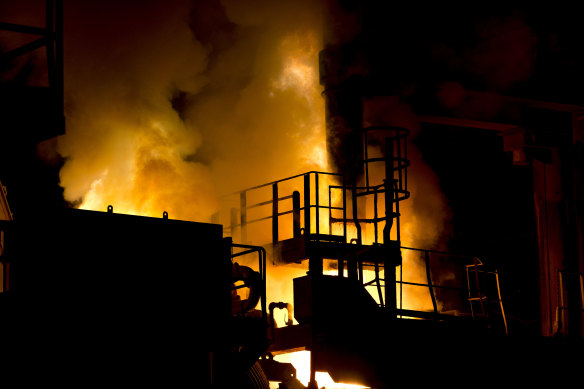By Peter Milne
Australia has vast resources of iron ore and renewable energy for low-emissions steel-making but must address high costs, slow approvals and the wrong type of rock or risk other countries grabbing the opportunity, according to a report by the World Wide Fund for Nature.
At stake are Australia’s $138 billion of annual iron ore exports, which consist almost entirely of haematite ore from the Pilbara that is unsuitable for producing green steel with current technology due to impurities and low iron content.

Unlike older technology coal-fired blast furnaces, electric arc furnaces can produce zero-emissions steel.Credit: Daniel Acker, Bloomberg
Nicole Wyche, WWF steel decarbonisation manager and report co-author said a lot of work between iron ore miners and their steel mill customers was focused on how to keep using Pilbara haematite while reducing emissions.
Miners BHP and Rio Tinto and steelmaker Bluescope plan to operate an electric smelting furnace pilot plant in Australia as early as 2027 to test making iron from Pilbara ore with renewable energy instead of coal-fired blast furnaces that dominate steel making.
Rio Tinto will also build a $215 million facility south of Perth to trial another new technology, BioIron. Microwave energy will heat the ore instead of burning coal and the carbon needed to turn iron onto steel will come from biomass such as straw. Fortescue plans to produce trial quantities of green iron in the Pilbara in 2025.
The alternative to new steel-making technology that can use haematite is for miners to produce magnetite instead. It makes up 38 per cent of Australia’s iron ore resources, has fewer impurities and can be processed to increase its grade.
If the steel industry was a country it would be the world’s third-largest emitter of greenhouse gases after the United States and China. Displacing those emissions will require an enormous amount of renewable energy.
Baethan Mullen, chief executive of green industry think tank The Superpower Institute, said the capacity to produce renewable energy in South and East Asian countries will mostly be used to decarbonise their domestic energy needs, leaving them little opportunity to produce green steel.
However, Wyche warned that Australia - with its combination of sun, wind, space and iron ore - should not think its natural advantages would be enough to compete in a fast-moving economy.
The position of Australia’s iron ore sector is worsened by the desire of its biggest customer, China, to diversify its supply sources, and Wyche warns that many rivals, including Brazil and some parts of Africa and the Middle East, are better placed to produce magnetite.
Developers of large-scale wind and solar developments in Australia are struggling to gain all the approvals—environmental, transmission connections, and agreements with Indigenous landholders—in a reasonable time frame.
The WWF report calls for the removal of approval bottlenecks for new green iron and steel developments without compromising environmental protection.
“What we’re seeing from the steel industry is really an industrial revolution,” Wyche said.
WWF is also calling for a national plan to future-proof the prosperity of Australia’s most valuable export, including, if necessary, developing a cost on carbon similar to the European Union’s Carbon Border Adjustment Mechanism that it describes as “a reality of the green economy.”
The Morning Edition newsletter is our guide to the day’s most important and interesting stories, analysis and insights. Sign up here.